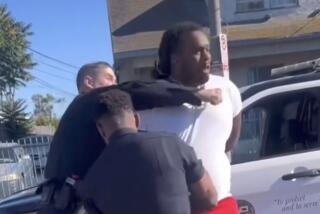Efficiency Will Sell LAPD Split
- Share via
Los Angeles Police Chief Bernard Parks last week recommended two big--and welcome--changes in the way the San Fernando Valley is policed. First, Parks suggested splitting the massive Valley Bureau into two units--a move that would bring administrative support in line with other parts of the city. Second, the chief called for the construction of a sixth police station to improve the connection between officers and the communities they protect.
Both steps are positive and long overdue. But they require money--perhaps as much as $41 million--and would represent the Valley’s largest expansion of public safety services in years. Although the recently rebuilt North Hollywood station and the new training center in Mission Hills provide better accommodations for officers, they do little to bolster street patrols.
The case for a split bureau and new station is compelling. Over the next 12 years, the Valley’s population is expected to grow 28%, nearly 400,000 new residents. Already, though, officers in the Valley are some of the busiest in the city. Service calls in Valley Bureau increased 2.7% from 1992 to 1996. Over the same period, service calls in the Central and South bureaus decreased and calls in West Bureau increased less than 1%. Last year, Valley officers fielded 263,000 calls for service--the most of any bureau in the city.
Splitting Valley Bureau--probably along Roscoe Boulevard--would make it easier for the LAPD command to manage operations in the city’s largest single geographic region. Special operations would be easier to coordinate and commanders could more readily identify crime patterns that might require changes in the way officers are deployed. Those largely managerial changes would help police do their jobs better, but generally would not be visible to the public. A new station would.
Parks’ proposal calls for the construction of a new facility between the Devonshire and Foothill stations, concentrating on the center of the Valley. The area--which is home to notoriously high-crime neighborhoods such as Orion Avenue and Blythe Street--can be difficult to patrol because it lies at the outer edge of coverage areas for the Devonshire, Foothill and Van Nuys stations. With new investment such as Wal-Mart and a shopping center on the site of the old General Motors assembly plant, the area is poised for a strong economic comeback. Better police protection would help.
That the Valley would benefit from Parks’ changes is indisputable. The Valley of the 1990s cannot adequately be patrolled and protected with a police structure from the 1970s. Paying for the improvements, however, depends on public approval of a bond measure scheduled to appear on the June ballot. That may be a tough sell. In 1989, voters approved a $176-million measure for new police facilities. It took nearly a decade for the city to build the promised facilities--including the new North Hollywood station--and the work was plagued by design flaws and cost overruns.
Like the rest of the city, the Valley wants a strong police force, but residents want their money spent responsibly. The LAPD’s first duty in selling a new bond issue will be proving that it can efficiently use the money and improve service.
More to Read
Sign up for Essential California
The most important California stories and recommendations in your inbox every morning.
You may occasionally receive promotional content from the Los Angeles Times.










